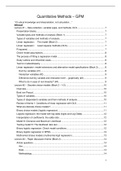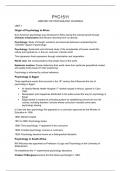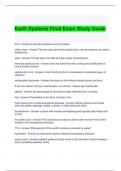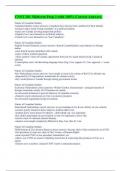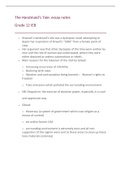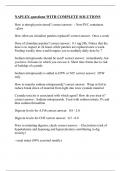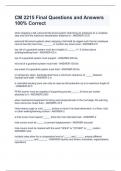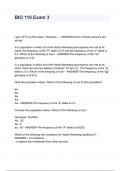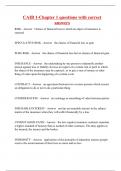Quantitative Methods – GPM
‘’It’s about knowledge and interpretation, not calculation…’’
Inhoud
Lecture #1 – Data collection, variable types, and methods, OLS ........................................... 7
Presentation blocks............................................................................................................ 7
Variable types and methods of analysis (Block 1) .............................................................. 7
Types of variables and methods of analysis ....................................................................... 7
Linear regression: The model (Block 2) .......................................................................... 7
Linear regression: Least squares methods (OLS)........................................................... 7
R-squared .......................................................................................................................... 7
Check model assumptions ................................................................................................. 8
The process of fitting a regression model........................................................................... 8
Study outliers and influential cases .................................................................................... 8
Test for multicollinearity ..................................................................................................... 8
Linear regression: model extensions and alternative model specifications (Block 3) .......... 8
Dummy variables (#1) .................................................................................................... 8
Interaction variables (#2) ................................................................................................ 9
Difference dummy variable and interaction term – graphically (#3) ................................. 9
What to do in case of non-linearity? (#4) ........................................................................ 9
Lecture #2 – Discrete choice models (Block 2 – 1/2) ............................................................10
Overview...........................................................................................................................10
Bord van Pascal................................................................................................................10
Types of variables .............................................................................................................10
Types of (dependent) variables and their methods of analysis ..........................................10
Review of theme 1: Conditions of linear regression with OLS ...........................................11
What are discrete choice models? ....................................................................................11
Binary choice models (logistic regression) ........................................................................11
Logistic regression: the model with log-odds (logits and Log-Odds) ..................................12
Interpretation of coefficients: the odds-ratio ......................................................................12
Model fit: Deviance and Maximum Likelihood ...................................................................12
Testing model fit: The likelihood ratio test .........................................................................12
Binary logistic regression: Check model conditions ...........................................................12
Binary logistic regression in SPSS ....................................................................................13
Multinomial choice models (multinomial logit regression) ..................................................13
Lecture #3 – Paper discussion theme (Block 2) ....................................................................14
Article questions ...............................................................................................................14
Aim ................................................................................................................................14
Data ..............................................................................................................................14
Methodology..................................................................................................................14
1
, Model quality and conditions .........................................................................................14
Lecture #4 – Structural Equation Modelling I ........................................................................16
Program Block 5: ..............................................................................................................16
Properties .........................................................................................................................16
Concepts ..........................................................................................................................17
Notation ............................................................................................................................17
Assumptions .....................................................................................................................18
Iterative process ...............................................................................................................18
Probabilistic ......................................................................................................................18
Matrix-notation ..................................................................................................................19
Causality & Complexity .....................................................................................................19
Causality .......................................................................................................................19
Sample size...................................................................................................................19
Type of relations or ‘effects’ ..............................................................................................19
Lecture #5 – Structural Equation Model II .............................................................................20
Types of relations or ‘effects’ (see lecture #4) ...................................................................20
Effects...............................................................................................................................20
Identification .....................................................................................................................21
Evaluation: Fit-indicators ...................................................................................................22
Evaluation: Adapting ......................................................................................................23
Lecture #6 – Structural Equation Modelling III ......................................................................24
This lecture .......................................................................................................................24
Measuring the unmeasurable ............................................................................................24
Measurement problem:..................................................................................................24
Types of factor analysis ....................................................................................................24
Procedure .........................................................................................................................25
Interpretation.....................................................................................................................25
Steps (in SPSS) ................................................................................................................25
Measurement scale...........................................................................................................25
Indicator rule .....................................................................................................................26
Iterative process ...............................................................................................................26
Issues concerning hybrid models ......................................................................................26
Lecture #7 – Structural Equation Modelling IV (+ Article) ......................................................27
Today ...............................................................................................................................27
Issues concerning hybrid models ......................................................................................27
Steps in model analysis ....................................................................................................27
Rounding up .....................................................................................................................27
Resumé (What you should know for the EXAM) ...............................................................28
Structural models and Suppression ..................................................................................28
2
, QUESTIONS: Evaluation: Fit-indicators .........................................................................29
Identification .....................................................................................................................29
Regression-coefficient, covariance, and variance .............................................................29
Article of Hallak, R., Brown, G. & Lindsay, N.J. (2012) ......................................................30
Lecture #8 – Latent Class Analysis (Block 4 – Huib Ernste) .................................................31
Different Kinds of Relationships ........................................................................................31
Factor Analysis .................................................................................................................31
Different Measurement Models .........................................................................................31
Latent Class Analysis........................................................................................................31
What is Latent Class Analysis? .........................................................................................32
A mixture of sub-populations.............................................................................................32
Looking for Local Independence .......................................................................................32
Association between two manifest categorical variables ...................................................32
Total Latent Cross-Table ..................................................................................................33
Local Independence..........................................................................................................33
Different ways of writing the same thing ............................................................................33
The Formal Model .............................................................................................................33
Parameters to be estimated ..............................................................................................34
Allocating observations to Latent Classes .........................................................................34
“Lem” (program) input .......................................................................................................34
Lem output........................................................................................................................34
Lecture #9 – Spatial Analysis ...............................................................................................35
Today ...............................................................................................................................35
Spatial analysis .................................................................................................................35
Spatial structures ..............................................................................................................35
Spatial data: ..................................................................................................................35
Character of the analysis (EXAM): ................................................................................35
Point-Central tendency ..................................................................................................35
Point-Spread .................................................................................................................35
Point-Correlation ...........................................................................................................35
Line-Central tendency ...................................................................................................36
Line-Spread...................................................................................................................36
Plane-Central tendency .................................................................................................36
Plane-Spread ................................................................................................................37
Plane-Correlation ..........................................................................................................37
Spatial sampling ...............................................................................................................38
Assignment .......................................................................................................................38
Next lectures .....................................................................................................................38
Lecture #10 – Temporal Analysis (Time series analysis) ......................................................39
3
, Overview...........................................................................................................................39
1. Introduction: the temporal dimension in quantitative analyses....................................39
Why is time relevant? ....................................................................................................39
Popular research designs to collect longitudinal data ....................................................39
2. Methods to interpret time series data (descriptive analysis) ..........................................39
Simple index..................................................................................................................40
Unweighted compound index ........................................................................................40
Weighted compound index ............................................................................................40
Laspeyres-index ............................................................................................................40
Paasche-index ..............................................................................................................40
Smoothing methods ..........................................................................................................41
Exponential smoothing: .................................................................................................41
3. Autocorrelation – Durbin-Watson test ........................................................................41
Test statistic Durbin-Watson d .......................................................................................41
Residuals against time ..................................................................................................42
SPSS output Durbin-Watson-test: Example 1 (no autocorrelation) ................................42
SPSS output Durbin-Watson-test: Example 2 (positive autocorrelation) ........................42
SPSS output Durbin-Watson-test: Example 3 (negative autocorrelation) .......................42
4. Methods to predict future values (explanatory analysis) .............................................43
Time series components ...............................................................................................43
Predicting: 1 exponential smoothing ..............................................................................43
Problems with predictions with exponential smoothing ..................................................43
Prediction: 2 Holt-Winters model ...................................................................................43
Simple linear regression ................................................................................................44
Two problems with simple linear regression ..................................................................44
Seasonal regression ......................................................................................................44
Precision of prediction ...................................................................................................44
Measures of precision ...................................................................................................45
Lecture #11 – Final group assignment ..................................................................................46
1. Instructions final assignment ......................................................................................46
Course aims ..................................................................................................................46
Themes .........................................................................................................................46
Final Group Assignment ................................................................................................46
Step #1..........................................................................................................................46
Step #2..........................................................................................................................46
Step #3..........................................................................................................................46
Step #4..........................................................................................................................46
Step #5..........................................................................................................................46
Submission and grading ................................................................................................47
4
, 2. Introduction to Eurostat data ......................................................................................47
3. Implementation example final assignment .................................................................47
Step #1..........................................................................................................................47
Step #2..........................................................................................................................47
Data selection ...............................................................................................................47
Step #3..........................................................................................................................47
Step #4..........................................................................................................................48
Step 5............................................................................................................................48
Lecture #12 – Paper and discussion meeting (theme blocks 5 & 6) ......................................49
What is the research aim? ................................................................................................49
Which data are used in this research? ..............................................................................49
Which methods are used? ................................................................................................49
Model #1: Exponential smoothing (= Holt-Winters) ...........................................................49
How is the choice for the Holt-Winters model reasoned?...............................................49
Model #2: Curve estimation ..............................................................................................50
What is meant by curve estimation? ..............................................................................50
Selection forecasting model / evaluation model quality ..................................................50
Forecast 2001-2010 ......................................................................................................50
Q&A Theme block 5 & 6 ...................................................................................................50
Autocorrelation – Durbin-Watson test ............................................................................50
Lecture #13 – Q&A and Practice Exam ................................................................................51
Questions: Spatial statistics / Geostatistics .......................................................................51
Some specific questions? ..............................................................................................51
Manhattan Median.........................................................................................................51
Standard deviation ........................................................................................................51
Tan(gens) and the Arc(tan) ...........................................................................................51
Standard Deviation Ellipse ............................................................................................51
Probability, Shape and Coefficient of Localization .............................................................52
Lorenz curve .................................................................................................................52
Joint Count Statistics & Geary’s Contiguity Ratio...........................................................52
Binary Logistic Regression ............................................................................................52
Multinomial Logit Regression.........................................................................................53
Identification ..................................................................................................................53
Structural models and Suppression ...............................................................................53
!!Practice Exam!! ...............................................................................................................53
5
,6
,Lecture #1 – Data collection, variable types, and methods, OLS
Presentation blocks
1. General considerations of QM;
2. Recap linear regression analysis (if dependent variable is metric);
3. Linear regression: Model extensions and alternative model specifications.
Variable types and methods of analysis (Block 1)
- Response variable (dependent variable) vs. explanatory variable (independent
variable);
- Manifest vs. latent variable (not directly observable/measurable, e.g. ‘globalization’)
Types of variables and methods of analysis
Linear regression: The model (Block 2)
- The conditional expectation of a continuous variable Y is expressed as a linear
function of the explanatory variables X1, X2 and Xm;
- Specific observations deviate randomly from the expected value, so we add a random
error term to the model:
Linear regression model (LRM)
Linear regression: Least squares methods (OLS)
The regression line is estimated with help of the least squares method: take the line, for
which the sum of squared residuals is as small as possible.
R-squared
- Prediction based on the estimated parameters:
- Residuals: deviations between predictions and observations
- R-square (goodness-of-fit) measures how well the model fits the observations, the
share of the variation of Y that is explained by the model:
7
, Check model assumptions
1. The sample consists of independent
observations. This means that the
observations must be independent.
2. A linear model is suitable, that is, the
relationship between the dependent
variable and the independent variables
is linear.
3. The variance of the residuals is equal
for all possible values of the
independent variables (constant
variance or homoscedasticity).
4. The residuals are normally distributed.
The process of fitting a regression
model
Steps to take before analyzing the model →
Study outliers and influential cases
Detect outliers:
- Look at observations beyond 3
standard deviations of mean;
- Boxplots, histograms, probability plots, scatter plots.
Study impact of influential cases:
- Idea is to compare regression outcomes with and without influential cases;
- SPSS: influence of case on individual coefficients (DFBETA) and on the model fit
(DFFIT);
- Influential cases with Cook’s distance > 1. (→ See Field (2018), p. 381-385)
Test for multicollinearity
- Multicollinearity = correlation between two (or more) explanatory variables is too high
(r < 0,8 or 0,9).
Problem:
- Standard errors of regression coefficients increase → untrustworthy coefficients;
- Limits size of R;
- Interpretation of relevance of individual explanatory variables becomes impossible.
Rules of thumb for detection:
- VIF > 10 (or tolerance < 0,1) → indicates serious problem of multicollinearity.
- VIF substantially higher than 1 (or tolerance < 0,2) → multicollinearity may be a
problem. (→ See Field (2018), p. 401-402)
Linear regression: model extensions and alternative model specifications
(Block 3)
Dummy variables (#1)
- To include qualitative variables in regression;
- E.g. ‘How can more study time result in lower grades?’
- What happens if we account for prior education levels of students?
The grades of students with a higher level of pre-education will be higher than those who
have a lower level of pre-education…
8
‘’It’s about knowledge and interpretation, not calculation…’’
Inhoud
Lecture #1 – Data collection, variable types, and methods, OLS ........................................... 7
Presentation blocks............................................................................................................ 7
Variable types and methods of analysis (Block 1) .............................................................. 7
Types of variables and methods of analysis ....................................................................... 7
Linear regression: The model (Block 2) .......................................................................... 7
Linear regression: Least squares methods (OLS)........................................................... 7
R-squared .......................................................................................................................... 7
Check model assumptions ................................................................................................. 8
The process of fitting a regression model........................................................................... 8
Study outliers and influential cases .................................................................................... 8
Test for multicollinearity ..................................................................................................... 8
Linear regression: model extensions and alternative model specifications (Block 3) .......... 8
Dummy variables (#1) .................................................................................................... 8
Interaction variables (#2) ................................................................................................ 9
Difference dummy variable and interaction term – graphically (#3) ................................. 9
What to do in case of non-linearity? (#4) ........................................................................ 9
Lecture #2 – Discrete choice models (Block 2 – 1/2) ............................................................10
Overview...........................................................................................................................10
Bord van Pascal................................................................................................................10
Types of variables .............................................................................................................10
Types of (dependent) variables and their methods of analysis ..........................................10
Review of theme 1: Conditions of linear regression with OLS ...........................................11
What are discrete choice models? ....................................................................................11
Binary choice models (logistic regression) ........................................................................11
Logistic regression: the model with log-odds (logits and Log-Odds) ..................................12
Interpretation of coefficients: the odds-ratio ......................................................................12
Model fit: Deviance and Maximum Likelihood ...................................................................12
Testing model fit: The likelihood ratio test .........................................................................12
Binary logistic regression: Check model conditions ...........................................................12
Binary logistic regression in SPSS ....................................................................................13
Multinomial choice models (multinomial logit regression) ..................................................13
Lecture #3 – Paper discussion theme (Block 2) ....................................................................14
Article questions ...............................................................................................................14
Aim ................................................................................................................................14
Data ..............................................................................................................................14
Methodology..................................................................................................................14
1
, Model quality and conditions .........................................................................................14
Lecture #4 – Structural Equation Modelling I ........................................................................16
Program Block 5: ..............................................................................................................16
Properties .........................................................................................................................16
Concepts ..........................................................................................................................17
Notation ............................................................................................................................17
Assumptions .....................................................................................................................18
Iterative process ...............................................................................................................18
Probabilistic ......................................................................................................................18
Matrix-notation ..................................................................................................................19
Causality & Complexity .....................................................................................................19
Causality .......................................................................................................................19
Sample size...................................................................................................................19
Type of relations or ‘effects’ ..............................................................................................19
Lecture #5 – Structural Equation Model II .............................................................................20
Types of relations or ‘effects’ (see lecture #4) ...................................................................20
Effects...............................................................................................................................20
Identification .....................................................................................................................21
Evaluation: Fit-indicators ...................................................................................................22
Evaluation: Adapting ......................................................................................................23
Lecture #6 – Structural Equation Modelling III ......................................................................24
This lecture .......................................................................................................................24
Measuring the unmeasurable ............................................................................................24
Measurement problem:..................................................................................................24
Types of factor analysis ....................................................................................................24
Procedure .........................................................................................................................25
Interpretation.....................................................................................................................25
Steps (in SPSS) ................................................................................................................25
Measurement scale...........................................................................................................25
Indicator rule .....................................................................................................................26
Iterative process ...............................................................................................................26
Issues concerning hybrid models ......................................................................................26
Lecture #7 – Structural Equation Modelling IV (+ Article) ......................................................27
Today ...............................................................................................................................27
Issues concerning hybrid models ......................................................................................27
Steps in model analysis ....................................................................................................27
Rounding up .....................................................................................................................27
Resumé (What you should know for the EXAM) ...............................................................28
Structural models and Suppression ..................................................................................28
2
, QUESTIONS: Evaluation: Fit-indicators .........................................................................29
Identification .....................................................................................................................29
Regression-coefficient, covariance, and variance .............................................................29
Article of Hallak, R., Brown, G. & Lindsay, N.J. (2012) ......................................................30
Lecture #8 – Latent Class Analysis (Block 4 – Huib Ernste) .................................................31
Different Kinds of Relationships ........................................................................................31
Factor Analysis .................................................................................................................31
Different Measurement Models .........................................................................................31
Latent Class Analysis........................................................................................................31
What is Latent Class Analysis? .........................................................................................32
A mixture of sub-populations.............................................................................................32
Looking for Local Independence .......................................................................................32
Association between two manifest categorical variables ...................................................32
Total Latent Cross-Table ..................................................................................................33
Local Independence..........................................................................................................33
Different ways of writing the same thing ............................................................................33
The Formal Model .............................................................................................................33
Parameters to be estimated ..............................................................................................34
Allocating observations to Latent Classes .........................................................................34
“Lem” (program) input .......................................................................................................34
Lem output........................................................................................................................34
Lecture #9 – Spatial Analysis ...............................................................................................35
Today ...............................................................................................................................35
Spatial analysis .................................................................................................................35
Spatial structures ..............................................................................................................35
Spatial data: ..................................................................................................................35
Character of the analysis (EXAM): ................................................................................35
Point-Central tendency ..................................................................................................35
Point-Spread .................................................................................................................35
Point-Correlation ...........................................................................................................35
Line-Central tendency ...................................................................................................36
Line-Spread...................................................................................................................36
Plane-Central tendency .................................................................................................36
Plane-Spread ................................................................................................................37
Plane-Correlation ..........................................................................................................37
Spatial sampling ...............................................................................................................38
Assignment .......................................................................................................................38
Next lectures .....................................................................................................................38
Lecture #10 – Temporal Analysis (Time series analysis) ......................................................39
3
, Overview...........................................................................................................................39
1. Introduction: the temporal dimension in quantitative analyses....................................39
Why is time relevant? ....................................................................................................39
Popular research designs to collect longitudinal data ....................................................39
2. Methods to interpret time series data (descriptive analysis) ..........................................39
Simple index..................................................................................................................40
Unweighted compound index ........................................................................................40
Weighted compound index ............................................................................................40
Laspeyres-index ............................................................................................................40
Paasche-index ..............................................................................................................40
Smoothing methods ..........................................................................................................41
Exponential smoothing: .................................................................................................41
3. Autocorrelation – Durbin-Watson test ........................................................................41
Test statistic Durbin-Watson d .......................................................................................41
Residuals against time ..................................................................................................42
SPSS output Durbin-Watson-test: Example 1 (no autocorrelation) ................................42
SPSS output Durbin-Watson-test: Example 2 (positive autocorrelation) ........................42
SPSS output Durbin-Watson-test: Example 3 (negative autocorrelation) .......................42
4. Methods to predict future values (explanatory analysis) .............................................43
Time series components ...............................................................................................43
Predicting: 1 exponential smoothing ..............................................................................43
Problems with predictions with exponential smoothing ..................................................43
Prediction: 2 Holt-Winters model ...................................................................................43
Simple linear regression ................................................................................................44
Two problems with simple linear regression ..................................................................44
Seasonal regression ......................................................................................................44
Precision of prediction ...................................................................................................44
Measures of precision ...................................................................................................45
Lecture #11 – Final group assignment ..................................................................................46
1. Instructions final assignment ......................................................................................46
Course aims ..................................................................................................................46
Themes .........................................................................................................................46
Final Group Assignment ................................................................................................46
Step #1..........................................................................................................................46
Step #2..........................................................................................................................46
Step #3..........................................................................................................................46
Step #4..........................................................................................................................46
Step #5..........................................................................................................................46
Submission and grading ................................................................................................47
4
, 2. Introduction to Eurostat data ......................................................................................47
3. Implementation example final assignment .................................................................47
Step #1..........................................................................................................................47
Step #2..........................................................................................................................47
Data selection ...............................................................................................................47
Step #3..........................................................................................................................47
Step #4..........................................................................................................................48
Step 5............................................................................................................................48
Lecture #12 – Paper and discussion meeting (theme blocks 5 & 6) ......................................49
What is the research aim? ................................................................................................49
Which data are used in this research? ..............................................................................49
Which methods are used? ................................................................................................49
Model #1: Exponential smoothing (= Holt-Winters) ...........................................................49
How is the choice for the Holt-Winters model reasoned?...............................................49
Model #2: Curve estimation ..............................................................................................50
What is meant by curve estimation? ..............................................................................50
Selection forecasting model / evaluation model quality ..................................................50
Forecast 2001-2010 ......................................................................................................50
Q&A Theme block 5 & 6 ...................................................................................................50
Autocorrelation – Durbin-Watson test ............................................................................50
Lecture #13 – Q&A and Practice Exam ................................................................................51
Questions: Spatial statistics / Geostatistics .......................................................................51
Some specific questions? ..............................................................................................51
Manhattan Median.........................................................................................................51
Standard deviation ........................................................................................................51
Tan(gens) and the Arc(tan) ...........................................................................................51
Standard Deviation Ellipse ............................................................................................51
Probability, Shape and Coefficient of Localization .............................................................52
Lorenz curve .................................................................................................................52
Joint Count Statistics & Geary’s Contiguity Ratio...........................................................52
Binary Logistic Regression ............................................................................................52
Multinomial Logit Regression.........................................................................................53
Identification ..................................................................................................................53
Structural models and Suppression ...............................................................................53
!!Practice Exam!! ...............................................................................................................53
5
,6
,Lecture #1 – Data collection, variable types, and methods, OLS
Presentation blocks
1. General considerations of QM;
2. Recap linear regression analysis (if dependent variable is metric);
3. Linear regression: Model extensions and alternative model specifications.
Variable types and methods of analysis (Block 1)
- Response variable (dependent variable) vs. explanatory variable (independent
variable);
- Manifest vs. latent variable (not directly observable/measurable, e.g. ‘globalization’)
Types of variables and methods of analysis
Linear regression: The model (Block 2)
- The conditional expectation of a continuous variable Y is expressed as a linear
function of the explanatory variables X1, X2 and Xm;
- Specific observations deviate randomly from the expected value, so we add a random
error term to the model:
Linear regression model (LRM)
Linear regression: Least squares methods (OLS)
The regression line is estimated with help of the least squares method: take the line, for
which the sum of squared residuals is as small as possible.
R-squared
- Prediction based on the estimated parameters:
- Residuals: deviations between predictions and observations
- R-square (goodness-of-fit) measures how well the model fits the observations, the
share of the variation of Y that is explained by the model:
7
, Check model assumptions
1. The sample consists of independent
observations. This means that the
observations must be independent.
2. A linear model is suitable, that is, the
relationship between the dependent
variable and the independent variables
is linear.
3. The variance of the residuals is equal
for all possible values of the
independent variables (constant
variance or homoscedasticity).
4. The residuals are normally distributed.
The process of fitting a regression
model
Steps to take before analyzing the model →
Study outliers and influential cases
Detect outliers:
- Look at observations beyond 3
standard deviations of mean;
- Boxplots, histograms, probability plots, scatter plots.
Study impact of influential cases:
- Idea is to compare regression outcomes with and without influential cases;
- SPSS: influence of case on individual coefficients (DFBETA) and on the model fit
(DFFIT);
- Influential cases with Cook’s distance > 1. (→ See Field (2018), p. 381-385)
Test for multicollinearity
- Multicollinearity = correlation between two (or more) explanatory variables is too high
(r < 0,8 or 0,9).
Problem:
- Standard errors of regression coefficients increase → untrustworthy coefficients;
- Limits size of R;
- Interpretation of relevance of individual explanatory variables becomes impossible.
Rules of thumb for detection:
- VIF > 10 (or tolerance < 0,1) → indicates serious problem of multicollinearity.
- VIF substantially higher than 1 (or tolerance < 0,2) → multicollinearity may be a
problem. (→ See Field (2018), p. 401-402)
Linear regression: model extensions and alternative model specifications
(Block 3)
Dummy variables (#1)
- To include qualitative variables in regression;
- E.g. ‘How can more study time result in lower grades?’
- What happens if we account for prior education levels of students?
The grades of students with a higher level of pre-education will be higher than those who
have a lower level of pre-education…
8


